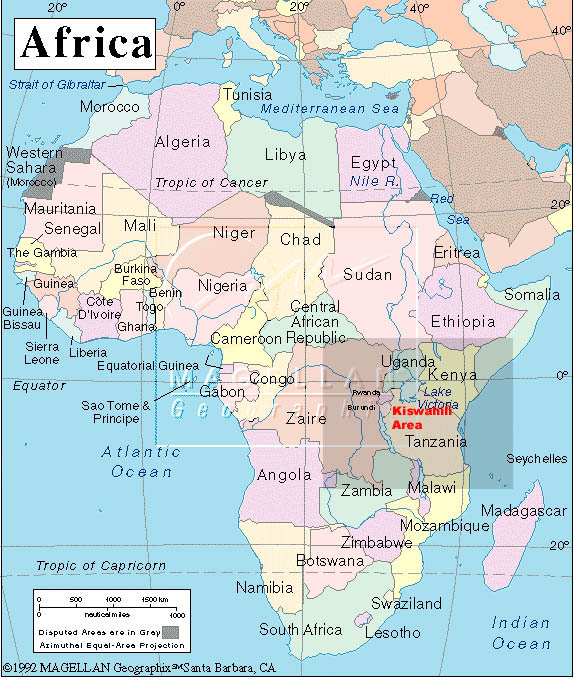 Kiswahili spread as trade language thanks to Arab caravans during the 18th and
the 19th centuries. It reached the Democratic Republic of the Congo as far as
the river Congo and down to the south east. Later, with the extensive exploitation
of copper mines many people of diverse tribes from neighboring provinces and
countries such as Zambia, Rwanda, Burundi and Angola, poured into the
area. With the pouring of linguistically disparate labor forces,
the resresort to Kiswahili seemed the most practical and suitable solution.
As the mines prospered, so did the use of the consolidation of a new variety
of Kiswahili–E. Polomé talks about creolization–in cities such as Lubumbashi, Likasi
and Kolwezi as newly multiethnic space. In the most recent time.
The linguistic complexity of the Katanga province is a mere reflection of the
whole country where at least two hundred and fifty languages co-exit. French
was imposed as the official language and four languages among which Kiswahili,
gained the status of linguae francae . The Kiswahili area comprises the
Oriental province, Maniema, South Kivu, North Kivu, Katanga, Western Kasai
and Easter Kasai. Till the Nineties, about half of the city populations in the Katanga
provinces were from or of Kasai stock, that is, mainly native speakers of L languages
such as Ciluba (L32 & L33). Their number has been diminished because of ethnic
cleansing under the authority of nativist politicians of the Mobutu-era.
It is estimated that about half a million people were thus displaced
from Katanga to the Kasais. The Copperbelt Kiswahili was influenced a great
deal by other Bantu languages represented by respective native speakers.
Among the most important ones are Kiluba-Shankadi, Ciluba-Kasai, Kisanga,
Kibemba, Rund’, Kihemba.
Kiswahili spread as trade language thanks to Arab caravans during the 18th and
the 19th centuries. It reached the Democratic Republic of the Congo as far as
the river Congo and down to the south east. Later, with the extensive exploitation
of copper mines many people of diverse tribes from neighboring provinces and
countries such as Zambia, Rwanda, Burundi and Angola, poured into the
area. With the pouring of linguistically disparate labor forces,
the resresort to Kiswahili seemed the most practical and suitable solution.
As the mines prospered, so did the use of the consolidation of a new variety
of Kiswahili–E. Polomé talks about creolization–in cities such as Lubumbashi, Likasi
and Kolwezi as newly multiethnic space. In the most recent time.
The linguistic complexity of the Katanga province is a mere reflection of the
whole country where at least two hundred and fifty languages co-exit. French
was imposed as the official language and four languages among which Kiswahili,
gained the status of linguae francae . The Kiswahili area comprises the
Oriental province, Maniema, South Kivu, North Kivu, Katanga, Western Kasai
and Easter Kasai. Till the Nineties, about half of the city populations in the Katanga
provinces were from or of Kasai stock, that is, mainly native speakers of L languages
such as Ciluba (L32 & L33). Their number has been diminished because of ethnic
cleansing under the authority of nativist politicians of the Mobutu-era.
It is estimated that about half a million people were thus displaced
from Katanga to the Kasais. The Copperbelt Kiswahili was influenced a great
deal by other Bantu languages represented by respective native speakers.
Among the most important ones are Kiluba-Shankadi, Ciluba-Kasai, Kisanga,
Kibemba, Rund’, Kihemba.
There is a range of terms used to designate this Kiswahili variant. Some refer to it as Kingwana, others as Katanga (Shaba) Kiswahili, others as Lubumbashi Kiswahili . Many other linguists–including me–prefer the term Copperbelt Kiswahili for two main reasons: